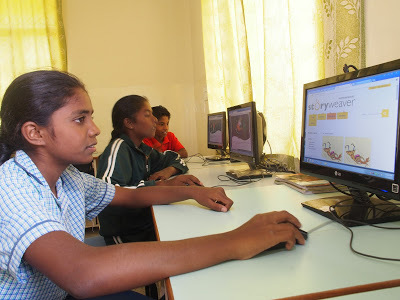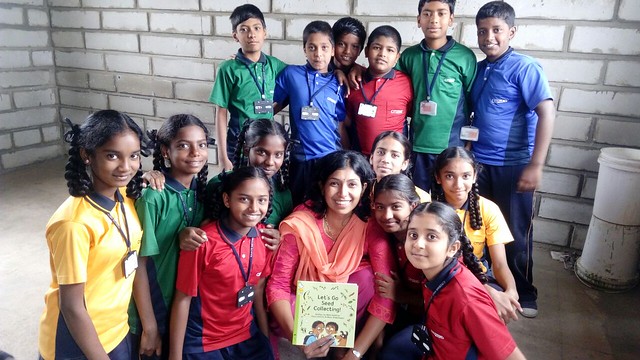Seeds, pets, forest canopies and simple machines: A story filled Saturday at Citizen's School
Posted by Remya Padmadas on February 01, 2017by Rahel Rao, Intern, Pratham Books StoryWeaver.
All children love stories. Especially when the stories are told to them in an animated manner or the stories come with illustrations, bringing them to life. With this in mind, on the 21st of January, 2017, Oracle India Volunteers partnered with Mantra4Change and Pratham Books StoryWeaver to conduct a storytelling session at Citizens Schools in Bengaluru.
The session was for classes 5 and 6 and the stories read to the classes were: Reeti and Mithu (Anupa Lal, Soumya Menon), Up Down, Down World (Padmaparna Ghosh, Sunaina Coelho), and Let’s Go Seed Collecting (Neha Sumitran, Archana Sreenivasan) along with a bonus story - Ammachi’s Amazing Machines (Rajiv Eipe) - read by Menaka Raman, from Pratham Books.
All these stories sparked discussions about animal abuse, deforestation, and other such topics which the children had an acute awareness of and were ready to engage in discussions about - they only needed an opportunity to voice their views.
The children in Class 6 gather around Menaka to see the illustrations of ‘Ammachi’s Amazing Machine’
The children enjoyed the sessions very much and their infectious enthusiasm made the experience better for the storytellers. You could see their faces lighting up when they realised that they were going to be told stories. They were alert and interactive throughout the sessions, ready to answer any questions asked and were even more excited when they realised that pictures were being taken of them. As Rashmi, an Oracle volunteer said, “[their reaction] was really awesome”.
They clearly enjoyed the stories too. Oracle volunteer, Pranjala, said that the stories available on StoryWeaver are filled with so much positivity. She added that it was very important that children from the underserved sections of society get the right values, saying, that "stories are a wonderful way to impart values to kids at this age, which they can carry with them for the rest of their lives”.
It was clear that initially the children weren’t very certain how to act around the storytellers. But they soon settled down, realising that it wasn’t a formal setting. This feeling was common even among the storytellers. Rajeshwari, who works with Oracle and was doing this for the first time, said that although she was a bit apprehensive when she heard that this was for the fifth and sixth grade, she found that they were really excited and later said that “overall it was a great experience” - an observation made by all the storytellers.
Rajeshwari with Class 6 after reading ‘Let’s Go Seed Collecting’
Rajeshwari also brought a guest, who used to be a teacher in a playschool, to do a storytelling session. She said that “storytelling is not just an oral rendition, it's more of an art to get children involved. They learn faster through stories” and was very excited when this opportunity came to her. She said that the stories on StoryWeaver were “told in such an adventurous way” and so the “small things which have been added in the book which they [the children] tend to overlook” were brought to their attention through the discussions that followed each story.
The entire morning was very heartening and the children even asked some of the the volunteers when they were coming back to do another session. Their level of interest and their love for stories was apparent, which only made the entire experience better and completely worthwhile.
Menaka (left) and Rashmi (right) talking to a class after the storytelling session.
Have you used StoryWeaver to conduct a storytelling session? Would you like to write about it for our blog? Send us an email at [email protected]
Be the first to comment.
How Digital Open Source Platforms Can Transform Learning
Posted by Remya Padmadas on June 15, 2016Radhika Oberoi writes for The Wire on how platforms like African Storybook are helping children overcome academic difficulties by making culturally specific stories borderless. She also mentions StoryWeaver and Pratham Books' 'Missed Call Do, Kahaani Suno' campaign.

'But before a story can be uploaded, downloaded, translated and shared, it has to be written. Among the ASb’s inexhaustible source of narratives is an Indian publisher of children’s literature, Pratham Books. Several original titles like Listen to my Body, The Moon and the Cap and The Elephant Bird have found their way to the ASb and captured the fascination of young readers across continents. Pratham Books’s own digital initiative, StoryWeaver, is a treasure trove of multi-lingual books, which, through a liberal Creative Commons licence, allows users to share and adapt stories as well as images in any medium. There are close to 1,800 stories, available for reading and sharing in 41 Indian and international languages. “While our Hindi and English stories continue to be very popular, we have seen the user community respond with great enthusiasm to Malayalam, Sanskrit, Telugu and recently, Tibetan and Santhali as well,” says Suzanne Singh, chairperson of Pratham Books.
Stories are the élan vital of open-source platforms, which prompt children to rapid fluency in the mother tongue, before they can read simple sentences in English. And perched upon the diaphanous wings of broadband transmission, stories can reach eager listeners through any digital medium. Pratham Books’s recent initiative, ‘Missed Call do, Kahaani Suno’ allows children to listen to audio stories in English, Hindi, Marathi or Kannada by leaving a missed call at a given number. An auto-generated call in response lets them pick the language of the story, followed by an SMS that links them to the story on StoryWeaver.'
You can read the entire article here.
A curated collection of African Storybook's stories can be found on StoryWeaver here.
Be the first to comment.StoryWeaver recognised by Digital Public Goods Alliance
Posted by Asawari Ghatage on August 03, 2022

Pratham Books’ StoryWeaver was reviewed and once again recognised by the Digital Public Goods Alliance. The goal of the DPGA and its DPG Registry is to promote digital public goods in order to create a more equitable world. Being recognized as a DPG increases the visibility, support for, and prominence of open projects that have the potential to tackle global challenges. To become a digital public good, all projects are required to meet the DPG Standard to ensure that projects truly encapsulate open source principles.
StoryWeaver seeks to provide children with the very step in their reading journey - storybooks. Our approach to creating book security is three-pronged: creating storybooks, enabling open access to these books and providing free resources to encourage the use of these books to help children read.
“For us, being recognized as a digital public good - defined as open source software, open standards and open content that adhere to privacy and other applicable laws and best practices, do no harm, and help attain the SDGs - validates the work we have done to achieve our mission of ‘a book in every child’s hand’ through the power of collaboration, technology and open licensing.”
- Purvi Shah, Senior Director, Storyweaver
The Digital Public Goods Alliance is a multi-stakeholder initiative endorsed by the United Nations Secretary-General, working to accelerate the attainment of the Sustainable Development Goals in low- and middle-income countries by facilitating the discovery, development, use of, and investment in digital public goods.
Be the first to comment.